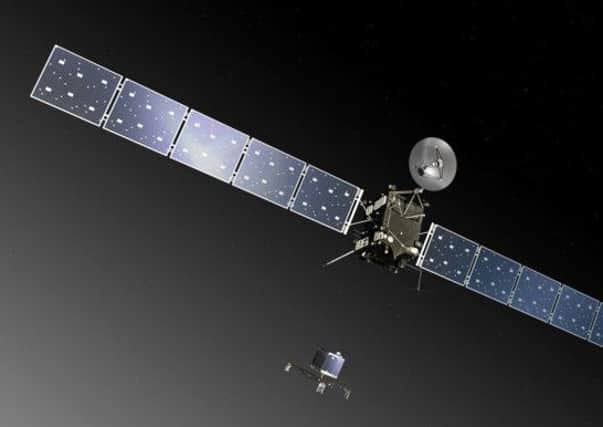Rosetta spacecraft begins work after two-year sleep


The craft, whose mission is to land on a speeding comet, re-established contact with controllers at 6:17pm yesterday after being silent for more than two years.
The message took 45 minutes to travel half a billion miles across space but means the craft is now on course to rendezvous, more than ten years after its launch, with a comet known as Comet67P/Churyumov-Gerasimenko in August.
Advertisement
Hide AdAdvertisement
Hide AdAt the European Space Agency (ESA) headquarters in Darmstadt, south-west Germany, there were nail-biting moments as the hour-long window of opportunity began but after 45 minutes there were cheers of delight as the all-important contact was made.
As Gerhard Schwehm, mission manager for Rosetta, said: “After 31 months in hibernation, what is 45 minutes to wait.”
The message was received as a spike on a computer screen confirming that Rosetta’s automated systems were working as expected. The ESA also published a tweet from the spacecraft which read: “Hello World.”
An automatic “alarm call” roused the Rosetta probe from its “hibernation mode” slumber at 10am yesterday.
The message was sent after a six-hour “wake-up” procedure had been completed and then had to travel almost 500 million miles across space. Rosetta is now around 5.6 million miles from its destination and closing on the object at half a mile a second.
The spacecraft, launched by ESA from Kourou in French Guiana nearly ten years ago, is on a historic mission to drop a landing craft on the icy surface of a comet.
One of its first tasks after reaching the comet will be to search for a suitable landing site for the Philae landing craft, which will be deployed to drill samples from the ground for analysis.
Philae will also capture panoramic images of the view from the comet’s surface.
Advertisement
Hide AdAdvertisement
Hide AdScientists hope Rosetta will answer important questions about the origins of the solar system and the way comets evolve and develop.
Rosetta was put to sleep to conserve power as it headed to regions as distant as the planet Jupiter, where the Sun’s weak rays provide only limited amounts of energy.
Unlike other long-distance space probes, the craft has no nuclear batteries and instead relies on electricity generated by 15-metre long solar panels.
Scientists planned to hibernate Rosetta for 957 days before bringing its main systems back on line and to make certain it woke up, the craft was fitted with not one, but four, quartz “alarm clocks”.
The wake-up procedure involved switching on the probe’s star-tracker navigation system, slowing its spin and warming up electrical components.
Rosetta, named after the block of stone that helped archaeologists decipher ancient Egyptian hieroglyphics, has already travelled around the Sun five times.
Comet 67P/Churyumov-Gerasimenko is a 2.5 mile-wide dirty snowball of ice and dust hurtling through space at 24,600mph. Rosetta is due to reach the comet in August before deploying the Philae lander in November.
Scientists have compared the mission to trying to land a fly on a speeding bullet.
Advertisement
Hide AdAdvertisement
Hide AdJean-Jacques Dordain, director general of ESA, said: “Rosetta is a unique mission, unique technologically, unique scientifically, and unique philosophically because comets may be the origin of who we are.”